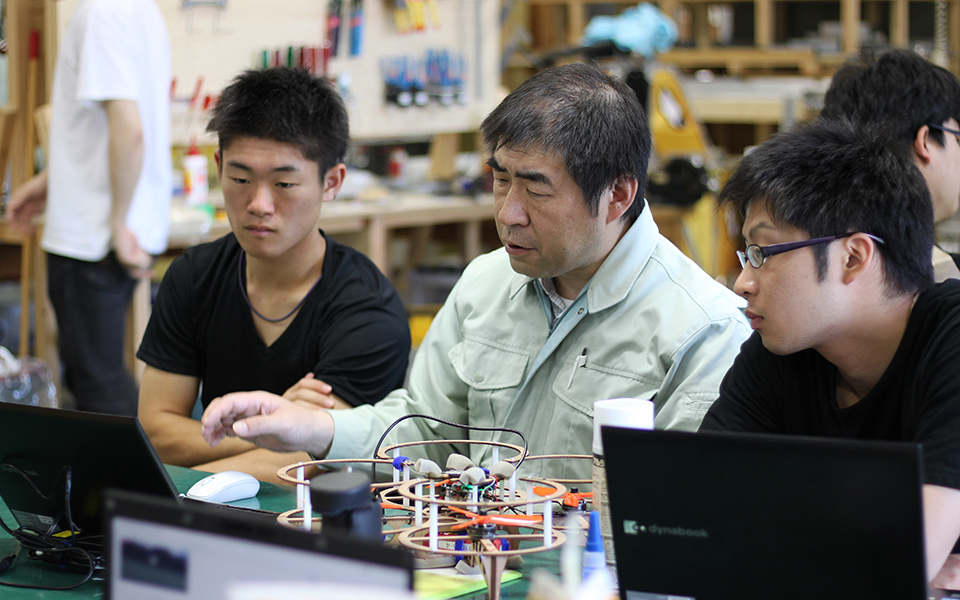"空飛ぶロボット"を夢見て
Drone Project by Ito Lab
伊藤 恒平 教授/ Professor Kohei Ito
学生時代から航空宇宙工学やコンピュータサイエンス、ロボットなどを研究してきた伊藤恒平先生。最近はドローンを通して、自動制御や人工知能の新たな可能性を学生に伝えています。高専ロボコンやマイクロマウスの指導経験も豊富な伊藤先生に、新しいモノを生み出す楽しさを聞きました。

伊藤 恒平
国際高等専門学校 教授
防衛大学校航空宇宙教室卒業後、同大学院理工学研究科(航空宇宙)修了。筑波大学大学院博士後期課程(コンピュータサイエンス)修了。平成18年、本校助教授に就任し、同21年教授。専門は制御工学、システム工学。
―空中での撮影や宅配サービス、災害現場への派遣など、さまざまな場面で登場することが多くなりましたが、そもそも、ドローンとは何ですか?
ドローンとは、簡単に言うと「無人飛行ロボット」です。リモコンで操作するラジコンタイプのものと、プログラミングによる制御で動く自律式のものがあります。複数のプロペラで飛ぶ「マルチコプター」がよく知られていますが、いわゆる飛行機の形をした固定翼タイプのものもあります。私が研究しているのは自律制御のタイプで、メインは制御プログラムの作成ですが、フレームもオリジナルのものをデザインし、レーザーカッターなどを使って作っています。
―ドローンの研究を始めたきっかけは何ですか?
20年以上前になりますが、大学時代に所属した航空宇宙教室で、人工知能の研究に出会いました。人間の脳を構成する神経細胞の「ニューロン」をコンピュータで再現した「ニューラルネットワーク」を使って、飛行機を自動制御できないかと考えたんです。結論から言うと、当時のコンピュータの性能では計算速度が遅すぎて、人工知能に必要な膨大な量のデータを処理できず、うまくいきませんでしたが、これが飛行制御研究のスタートでした。
―飛行制御の研究を活かす対象がドローンというわけですね。
元々、ロケットを作りたいという夢があり、とにかく「飛ぶモノ」を作りたかったんです。それで、飛行機などの飛翔体が飛行するためのプログラミング制御を一貫して研究してきました。ドローンはその研究対象としてうってつけであるだけでなく、学生が総合的なシステム設計力を養うための教材としても非常に優れています。制御の概念やプログラミング、設計、製作、モーターのスペック、電池の必要量など、1台のドローンを飛ばすために、さまざまな知識と技術が必要ですから。
企業との共同研究も進めており、東京航空計器という会社と、フライトコントローラーの開発に取り組んでいます。フライトコントローラーはドローンを安定して飛行させるための重要な部品で、私は主に飛行実験を担当し、完成度を高めるために協力しています。白山麓キャンパスでも、広い敷地を活かして実験する予定なので、学生にもぜひ参加してほしいですね。
―マイクロマウスの研究にも熱心ですね。
マイクロマウスは30年以上の歴史があり、日本で初めて行われたロボコンと言われています。3メートル四方の迷路を自律制御で、つまりロボットが自分で考えながらルートを探索し、最短ルートを見つけてゴールを目指す競技です。どのような制御プログラムで迷路にアプローチをするかがそれぞれの腕の見せ所で、マイクロマウスの魅力でもあります。全国大会も行われていて、国際高専からも毎年、学生が出場しています。また、マイクロマウスの技術向上と交流を目的に、8年前から金沢で、草の根大会を主催しています。学生だけでなく、一般の「マウサー」も大勢集まり、世代や専門分野を超えて、技術や知識を交換して盛り上がっています。今年は国際高専の白山麓キャンパスで開催予定です。
―新しいモノを創造したい学生にとっては魅力的な話です。
ドローンにしろマイクロマウスにしろ、回路設計からプログラミング、外装製作など、ロボット作りにかかわるさまざまな技術と知識を学ぶことができます。今後は、授業で自律制御の校内案内ロボットを作ろうと思っています。階段を上るのが難しいので、上の階を案内するためにはドローンがいいかなとか・・・アイデアを考えるのは楽しいです。学生にもこの楽しさを伝えたいですね。
"空飛ぶロボット"を夢見て
Drone Project by Ito Lab
伊藤 恒平 教授/ Professor Kohei Ito
Ito Kohei sensei has studied aerospace engineering, computer science, and robotics since he was a student. Recently, he is teaching the fun of automatic control and artificial intelligence to students using drones. Ito sensei is highly experienced in instructing Kosen Robo Con and Micromouse. We asked him the enjoyment of creating something new.

Ito Kohei
International Collage of Technology Professor
Graduated from National Defense Academy of Japan department of aerospace engineering. Completed master's course in aerospace engineering, graduate school of the same name and doctor's course in computer science at University of Tsukuba. Began teaching at ICT as associate professor in 2006 and advanced to professor in 2009. Specialty is control engineering and system engineering.
―Drones now have a wide range of use such as aerial photography, delivery service, work in disaster sites, etc. However, what actually is a drone?
A simple definition of a drone is "an unmanned flying robot". There are radio-controlled drones using remote control and autonomous drones that move via programming. Many people know the "Multicopter" (drone type with multiple propellers). However, there are fixed-wing type drones shaped like airplanes. My personal research focuses on autonomous drones; more specifically the creation of control programs but I also design original frames and create them using laser cutters.
―What started your interest for drones?
More than twenty years ago, I joined an aerospace class in university, which was my first contact with the research of artificial intelligence. My initial motivation was to replicate human brain neurons using a computer to create a "neural network" to automatically fly an airplane. Long story short, the project did not work out because the compute technology at the time could not process the large amount of data necessary for the AI fast enough. Although not successful, this was my starting point for beginning research in flight control.
―Drones are the best target for your research on flight control?
I have always dreamed of building a rocket. I just wanted to make "flying things". That is why I have continued my research on control programming for aircrafts such as the airplane. Not only are drones perfect research material but they are also excellent learning material to teach students general system construction. To create a flying drone, you need to have various knowledge and skills such as a general understanding of control engineering and programing, design, manufacturing, motors and batteries.
I also belong to a research team with a corporation called Tokyo Aircraft Instrument to develop flight controllers. Flight controllers are an important component for stable drone flight. My role is mainly to conduct flight tests and help improve the controllers. I plan to conduct tests at our new Hakusanroku campus and I hope students will join in.
―I heard you are also involved in Micromouse research.
Micromouse has a history of over thirty years and is said to be the first Robo Con (robot contest) held in Japan. The mouse has to complete a three by three meter square maze using autonomous control. Basically, the robot has to think by itself. The first one to reach the goal wins. What kind of control program the engineer creates and how he/she approaches the maze depends on the person and is what makes the Miromouse so interesting. There is a national championship tournament and ICT students participate every year. Also, we hold small Micromouse tournaments to improve our skill and interact with the community. Many student and non-student "mousers" gather to exchange technology and wisdom. It is a very lively event. This year we are planning to hold it at ICT's Hakusanroku campus.
―Sounds exciting for students looking to create new things.
Both drones and Micromouses teach a variety of robot related technology and knowledge such as circuit design, programming and hardware creation. I am planning a class to make an autonomous school guide robot. Stairs are a big obstacle so maybe drones are the best choice... It is fun just to come up with ideas. I hope students will share my interests.



